United States Navy SEAL selection and training
_graduating_class_236.jpg)
The average member of the United States Navy's Sea, Air, Land Teams (SEALs) spends over a year in a series of formal training environments before being awarded the Special Warfare Operator Naval Rating and the Navy Enlisted Classification (NEC) 5326 Combatant Swimmer (SEAL) or, in the case of commissioned naval officers, the designation 1130 Naval Special Warfare (SEAL) Officer. All Navy SEALs must attend and graduate from their rating's 24-week "A" School known as Basic Underwater Demolition/SEAL (BUD/S) school, a basic parachutist course and then the 26-week SEAL Qualification Training program.[1]
All sailors entering the SEAL training pipeline with a medical rating or those chosen by Naval Special Warfare Command must also attend the 6-month Advanced Medical Training Course 18D and subsequently earn the NEC SO-5392 Naval Special Warfare Medic before joining an operational Team. Once outside the formal schooling environment SEALs entering a new Team at the beginning of an operational rotation can expect 18 months of training interspersed with leave and other time off before each 6-month deployment.
Screening
| Pipeline phase | Success percent | Overall percent |
|---|---|---|
| Signed enlistment | 79% | 79% |
| Graduated recruit training | 58% | 46% |
| Completed SEAL pre-indoctrination | 90% | 41% |
| Completed SEAL indoctrination | 85% | 35% |
| Completed BUD/S phase 1 | 33% | 12% |
| Completed BUD/S phase 2 | 87% | 10% |
| Completed BUD/S phase 3 | 96% | 10% |
| Graduated Airborne School | 100% | 10% |
| Completed SEAL Qualification Training | 99% | 10% |
Entering training to become a Navy SEAL is voluntary, and officers and enlisted men train side-by-side. To volunteer, SEAL candidates must be between 18 and 29 years old, and US citizens in the U.S. Navy. Occasionally, personnel from foreign armed forces allied with the United States will also be invited to take part in BUDS training. For a period of two years, of an initial seven planned,[3] members of the Coast Guard were allowed to attend SEAL training until the exchange program was suspended in 2011.[4] Waivers are available for 17-year-olds with parental permission and on a case-by-case basis for 29- and 30-year-olds.[5] Academically, all applicants must have the equivalent of a high school education, have a composite score of at least 220 on the ASVAB and be proficient in all aspects of the English language. Medically, all potential applicants must have at least 20/75 vision, correctable to 20/20, be able to pass the SEAL Physical Screening Test and have no recent history of drug abuse. Lastly applicants must have "good moral character" as determined by his history of criminal convictions and civil citations.[6][7]
The U.S. Navy, as of August 2015, is developing a plan for women to eventually join the SEALs, if they can meet the same acceptance guidelines as men, following the decision by President Obama and the U.S. Defense Department to open all uniformed service positions to women within a reasonable time span, unless the services are able to receive a waiver from the Secretary of Defense.
Assessment
Assignment to BUD/S is conditional on the SEAL Physical Screening Test (PST). Prospective trainees are expected to exceed the minimums. The minimum requirements are 500 yd (460 m) swim using breast or combat sidestroke in under 12:30 with a competitive time of 9:00 or less, at least 50 push-ups in 2 minutes with a competitive count of 90 or more, at least 50 sit-ups in 2 minutes with a competitive count of 90 or more, at least 10 pull-ups from a dead hang (no time limit) with a competitive count of 18 or more, run 1.5 mi (2.4 km) in running shorts and boots in under 10:30 with a competitive time of 9:30 or less.[8][9]
Naval Special Warfare Preparatory School (8 weeks)
The training curriculum begins at Naval Special Warfare Preparatory School in Great Lakes, Illinois. Here, aspiring SEALs are given a crash course in the physical standards required to even attempt to become a SEAL.
It starts with the initial Physical Screening Test and ends with a more demanding Physical Screening Test, one that includes a timed four-mile run and a timed 1,000-meter swim. The goal is to increase the SEAL candidates' physical readiness between the two tests so that they are ready to move on to Basic Underwater Demolition/SEAL (BUD/S) Training. Those unable to pass the final test are removed from the SEAL training pipeline and reclassified into other jobs in the Navy.[10][11]
Basic Underwater Demolition/SEAL (BUD/S) Training (24 weeks)
BUD/S is a 24-week training challenge that develops the SEAL candidates' mental and physical stamina and leadership skills. Each BUD/S phase includes timed physical condition tests, with the time requirements becoming more demanding each week. BUD/S consists of a three-week orientation followed by three phases, covering physical conditioning (seven weeks), combat diving (seven weeks), and land warfare (seven weeks) respectively. Officer and enlisted personnel go through the same training program. It is designed to develop and test their stamina, leadership, and ability to work as a team.[12]
Indoctrination (INDOC) (3 weeks)
BUD/S INDOC is a three-week course that introduces candidates to Coronado, the Naval Special Warfare Center and the BUD/S lifestyle. During INDOC, Navy SEAL instructors introduce candidates to BUD/S physical training, the obstacle course and other unique training aspects. This part of training is designed to prepare candidates for day one of the first phase.[10][13][14]
Phase 1: Physical Conditioning (7 weeks)
The first phase of BUD/S assesses SEAL candidates in physical conditioning, water competency, teamwork and mental tenacity. Physical conditioning utilizes running, swimming and calisthenics and grows harder and harder as the weeks progress. Candidates will participate in weekly four mile timed runs in boots and timed obstacle courses, swim distances up to two miles wearing fins in the ocean and learn small boat seamanship.[10][15]
The first two weeks of basic conditioning prepare candidates for the third week, also known as "Hell Week." During Hell Week, candidates participate in five and a half days of continuous training. Each candidate sleeps at most four hours during the entire week, runs more than 200 miles, and does physical training for more than 20 hours per day. The remaining four weeks involve the acquisition of various methods of conducting hydrographic surveys and creating a hydrographic chart.[10][15]
Because of its particularly challenging requirements, many candidates begin questioning their decision to come to BUD/S during First Phase, with a significant number deciding to Drop on Request (DOR). The tradition of DOR consists of dropping one's helmet liner next to a pole with a brass ship’s bell attached to it and ringing the bell three times.[10][14][15]
It has been reported that all candidates receive two medical examinations within 24 hours after Hell Week.
Phase 2: Combat Diving (7 weeks)
The diving phase of BUD/S trains, develops and qualifies SEAL candidates as competent basic combat swimmers. During this period, physical training continues and becomes even more intensive. This second phase concentrates on dive physics, underwater skills and combat SCUBA. Candidates will learn two types of SCUBA: open circuit (compressed air) and closed circuit. Also, basic dive medicine and medical skills training is provided.[10][16]
Emphasis is placed on long-distance underwater dives with the goal of training students to become basic combat divers, using swimming and diving techniques as a means of transportation from their launch point to their combat objective. This is what separates SEALs from all other US special operations forces.[10][16] By the end of Second Phase, candidates must complete timed 2-mile swim with fins in 80 minutes, the four-mile run with boots in 31 minutes, a 3.5-mile and 5.5-mile swim.
Successful second phase candidates demonstrate a high level of comfort in the water and the ability to perform in stressful and often uncomfortable environments. Candidates who are not completely comfortable in the water often struggle to succeed.[10][16]
Phase 3: Land Warfare (7 weeks)
The land warfare phase teaches the class basic weapons, demolitions, land navigation, patrolling, rappelling, marksmanship and small-unit tactics. During third phase, the class is taught to gather and process information that will complete the overall mission. There is more classroom work that teaches map, compass, land navigation and basic weapon skill sets. These skill sets allow the class to transition from having novice skills to becoming more comfortable out in the field. Most of this training is new to the class, and the learning pace becomes faster and faster.[10][17]
For the final three and a half weeks of training, the class goes offshore, about 60 miles from Coronado to San Clemente Island. On the island, the class practices the skills they learned in third phase. The days become longer and more work intensive, set to mirror the work hours spent in the field.[10][17] Many students view this as one of the hardest parts of training, as training is conducted seven days a week, with very minimal sleep, all while handling live explosives and ammunition. Interaction with instructors is also never ending, and punishments are at their harshest levels yet. By the end of Third Phase, candidates must complete a timed 2 mile ocean swim with fins in 75 mins, 4-mile timed run with boots in 30 mins and complete a 14-mile run.
_class_245_with_learning_the_importance_of_listening.jpg)
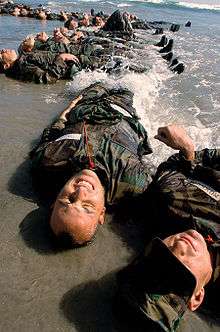

_students_take_part_in_Log_PT.jpg)
_Adm._Mike_Mullen_prepares_to_secure_students_of_Basic_Under_Water_Demolition_Seal_Training_(BUDS)_Class_266_from_the_Hell_Week_portion_of_their_training.jpg)

_Instructor_is_about_to_show_a_member_of_BUD-S_Class_244_just_how_hard_it_can_be_to_rescue_a_drowning_victim.jpg)

_candidates_check_their_underwater_breathing_apparatuses_for_proper_ventilation_and_safety_before_participating_in_dive_training_in_Coronado_Bay.jpg)
_student_wades_ashore_on_San_Clemente_Island_during_an_over_the_beach_exercise.jpg)
_students_conduct_a_patrolling_exercise_during_the_third_phase_of_training_at_Naval_Amphibious_Base_Coronado.jpg)
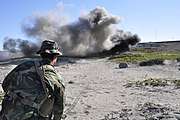

_candidate_Seaman_Jared_Hougtalen_plots_coordinates_to_his_next_checkpoint_during_an_individual_basic_land_navigation_exercise.jpg)

Parachute Jump School (3 weeks)
Upon successful completion of BUD/S, SEAL candidates go on to receive both static line and free-fall training at Tactical Air Operations in San Diego, CA. The accelerated 3-week program is highly regimented, facilitated by world-class instructors, and designed to develop safe and competent free-fall jumpers in a short period of time.[10]
To complete the course, candidates must pass through a series of jump progressions, from basic static line to accelerated free fall to combat equipment – ultimately completing night descents with combat equipment from a minimum altitude of 9,500 feet.[10]
SEAL Qualification Training (SQT) (26 weeks)
SEAL Qualification Training (SQT) is a 26-week course that will take the student from the basic elementary level of Naval Special Warfare to a more advanced degree of tactical training. SQT is designed to provide students with the core tactical knowledge they will need to join a SEAL platoon.[10][18]
The class will learn advanced skill sets in weapons training, close-quarters combat, small unit tactics, land navigation, demolitions, unarmed combat, cold weather training in Kodiak, Alaska, medical skills and maritime operations. Before graduating, students also attend Survival, Evasion, Resistance and Escape training.[10][18]
Graduation from SQT culminates in the awarding of the coveted Navy SEAL Trident and granting of the Navy Enlisted Classification (NEC) 5326 Combatant Swimmer (SEAL) or 1130 Special Warfare (SEAL) officer. New SEALs are immediately assigned to a SEAL Team at Coronado, Ca or Little Creek, Va and begin advanced training for their first deployment.[10][18]
_students_from_Class_268_perform_buddy_carries.jpg)


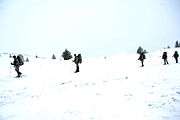

SEAL Troop (TRP) Training
Following SQT, new SEALs will receive orders to a SEAL Team and assignment to a Troop (TRP) and subordinate Platoon (PLT). New operators will join their Platoon wherever they are in their deployment cycle. The normal workup or pre-deployment workup is a 12- to 18-month cycle divided into three phases.
Individual Specialty Training
Phase one of a work-up is Individual Specialty Training. Individual Specialty Training is 6 months long where individual operators attend a number of formal or informal schools and courses. These schools lead to required qualifications and designations that collectively allow the platoon to perform as an operational combat team. Depending on the team's and platoon's needs, operators can expect to acquire some of the following skills (Items in parentheses are Joint SOF Unit Course equivalent):[10][19][20]
- SEAL Sniper Course | USMC Scout Sniper Course
- Advanced Close Quarter Combat/Breacher (Barrier Penetration/Methods of Entry)
- Surreptitious Entry (Mechanical and Electronic Bypass)
- (18D) Special Operations Combat Medic Course
- NSWCFC (Naval Special Warfare Combat Fighting Course)
- Advanced Special Operations (MSO)
- Technical Surveillance Operations
- Advanced Driving Skills (Defensive, Rally, Protective Security)
- Climbing/Rope Skills
- Advanced Air Operations: Jumpmaster or Parachute Rigger
- Diving Supervisor or Diving Maintenance-Repair
- Range Safety Officer
- Advanced Demolition
- High Threat Protective Security (PSD) – (US/Foreign Heads of State or High Value Persons of Interest)
- Instructor School and Master Training Specialist
- Unmanned Aerial Vehicle Operator
- Language School
- Joint SOF and Service Professional Military Education (JPME)
Unit Level Training
Phase two of a work-up is called Unit Level Training (ULT). ULT is a 6-month block run by the respective group (NSWG1/NSWG2) training detachment, where the TRP/PLT's train in their core mission area skills: Small unit tactics, land warfare, close quarters combat, urban warfare, hostile maritime interdiction (VBSS/GOPLATS), combat swimming, long range target interdiction, rotary and fixed wing air operations and special reconnaissance.[10]
Task Group Level Training
Phase three of a work-up is Task Group Level Training. Task Group Level Training is the last 6-month block wherein a troop conducts advanced training with the supporting attachments/enablers of a SEAL Squadron: Special Boat Teams (SWCC), Intelligence(SI/HI/ETC)Teams, Cryptological Support Teams, Communications (MCT/JCSE) Medical Teams, EOD, Interpreters/Linguist, etc. A final Certification Exercise (CERTEX) is conducted with the entire SEAL Squadron (SQDN) to synchronize Troop (TRP) operations under the Joint Special Operations Task Force (JSOTF) umbrella. Following CERTEX, a SEAL Team becomes a SEAL Squadron and is certified for deployment.[10]
Once certified, a SEAL Team/Squadron will deploy to a Joint Special Operations Task Force or Area of Responsibility to become a Special Operations Task Force (SOTF), combine with a Joint Task Force (JTF) or Task Force (TF) in support of other National Objectives. Once assigned, the Troops will be given an Area of Operations (AOR) where they will either work as a centralized/intact Troop or task organize into decentralized elements (PLT-20/SQD-10/TM-5) to conduct operations. NSW Troops have ranged in size from 60 personnel to over 200 and can consist of SEAL's and any USSOCOM operational element and enablers. A SEAL Team/Squadron deployment currently is approximately 6 months, keeping the entire cycle at 12 to 24 months.
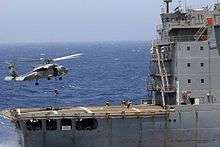

_receive_tactical_mobility_training.jpg)
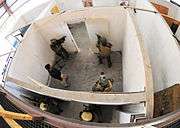
See also
References
- ↑ Dick Couch. The Finishing School. Three Rivers Press.
- ↑ "Navy steps up search for new SEALs – Navy News , News from Afghanistan & Iraq". Navy Times. 8 April 2007. Retrieved 19 May 2011.
- ↑ Lieutenant James McLay (DAG PAO) (21 May 2010). "Coast Guard Graduates First Two SEALs". Coast Guard Compass. United States Department of Defense. Retrieved 24 January 2013.
- ↑ Jill Laster (11 July 2011). "Program letting Coasties train as SEALs on hold". Coast Guard Guide. Coast Guard Guide. Retrieved 21 March 2017.
- ↑ Susan Gvozdas. "Coast Guardsmen are 1st to ever graduate BUD/S". Navy Times.
- ↑ Rod Powers. "Navy Enlisted Rating (Job) Descriptions and Qualification Factors SEAL Challenge". About usmilitary.com. Retrieved 24 February 2009.
- ↑ Allen, Admiral Thad. "Assignment Of Coast Guard Personnel To Train And Serve With Naval Special Warfare". Retrieved 5 November 2008.
- ↑ "SEAL PHYSICAL SCREENING TESTING STANDARDS AND PROCEDURES" (PDF). Retrieved 10 April 2013.
- ↑ "SEAL PST". Archived from the original on 8 April 2013. Retrieved 10 April 2013.
- ↑ "NSW Prep". Retrieved 10 April 2013.
- ↑ Center, Navy SEAL + SWCC Scout Team, Naval Special Warfare. "BUD/S TRAINING STAGES". SEALSWCC.COM. Retrieved 2018-07-10.
- ↑ "Basic Orientation". Retrieved 10 April 2013.
- 1 2 "BUD/S | Navy SEALs". Navy SEALs. Retrieved 2018-07-10.
- 1 2 3 "First Phase". Retrieved 10 July 2018.
- 1 2 3 "Second Phase". Retrieved 10 July 2018.
- 1 2 "Third Phase". Retrieved 10 July 2018.
- 1 2 3 "SEAL Qualification Training". Retrieved 10 April 2013.
- ↑ "Platoon Training , NavySEALs.com – Experience the SEAL Edge". NavySEALs.com. Archived from the original on 13 June 2011. Retrieved 19 May 2011.
- ↑ "Archived copy". Archived from the original on 14 July 2013. Retrieved 14 January 2013.
Further reading
- "Navy Fact File: Navy SEALs". San Diego: Naval Special Warfare Command – Public Affairs Office, United States Navy. 3 March 2005. Archived from the original on 3 March 2005. Retrieved 25 June 2006.
- McCoy, Shane T. (August 2004). "Testing Newton's Law", All Hands Magazine, p. 33.
- Obringer, Lee Ann. "How the Navy SEALs Work". How Stuff Works. Retrieved 14 June 2006.
- Sasser, Charles W. Encyclopedia of The Navy SEALs, Facts on File, 2002. ( ISBN 0-8160-4569-0)
- Scott Tyson, Ann (June 20, 2006). "Pulling No Punches in Push for Navy SEALs". The Washington Post.
External links
| Wikimedia Commons has media related to United States Navy SEALs. |
- Navy SEALs : Special Operations: Careers & Jobs: Navy.com - official site.
- U.S. Navy SEALs Information Website – official site.
- U.S. Naval Special Warfare Command Website – official site.
- US Navy SEALs Information
- US Navy SEALs Directory
- US Navy SEALs Blog

